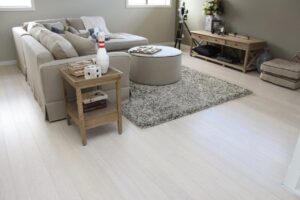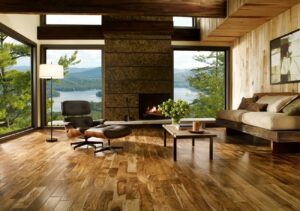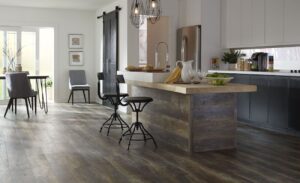Eco Cork Foam vs QuietWalk emerge as two prominent contenders in the market of flooring underlayment, each boasting unique attributes and benefits.
The layers beneath our floors are seldom seen but play a crucial role in the longevity and comfort of our flooring. The right underlayment can transform the feel of a room, acting as a foundation for durability and comfort.
As we delve into the intricacies of these two products, we understand their importance not just as mere layers, but as critical components that contribute to the overall performance of our floors.
By juxtaposing Eco Cork Foam or QuietWalk, we are set to engage in a detailed evaluation, dissecting their composition, moisture protection, sound absorption, and more, to guide you toward making an informed decision for your space.
Quick Comparison Between Eco Cork Foam and QuietWalk
| Feature | Eco Cork Foam (ECF) | QuietWalk |
|---|---|---|
| Material Composition | Polyethylene foam, granulated cork | Recycled fibers |
| Moisture Protection | 6 mil vapor barrier, moisture-preventative | Moisture control, anti-microbial for mold/mildew resistance |
| Sound Absorption | Superior; accredited certification for sound reduction | Excellent; high STC and IIC ratings |
| Sustainability | Biodegradable, recyclable, ultra-low VOC emissions | Uses recycled fibers, no VOC emissions |
| Installation Compatibility | Vinyl plank, laminate, wood; all U.S. climates | Vinyl, tile, multi-layer; including radiant heat systems |
| Thickness and Support | 3.2 mm for subfloor leveling and uniform support | Thin, dense fibers for solid support |
| Additional Features | Sound sealing tape, anti-microbial defense | Anti-microbial, comfort in temperature changes |
| Certifications and Ratings | Class 1 vapor impermeable, disclosed acoustical results | STC 62, IIC 70, Delta IIC 28 |
| R-Value | 0.48 | 0.50 |
| Rolls Availability | 75, 675, 300 sq. ft. | 360, 100 sq. ft. |
| Thickness Comparison | 3.2mm | 3.0mm |
| Surface Compatibility | Vinyl, wood, laminate | Floating wood, laminate (not for vinyl and ceramic tile) |
| Sound Absorption Rate | STC 67, IIC 73, F-IIC 23 | STC 54, IIC 58, F-IIC 60 |
| Overall Suitability | Waterproofing, antimicrobial, eco-friendly, sound absorption | Better R-value, not as protective for certain flooring types |
Dissecting Material Composition and Environmental Impact
Evaluating the makeup and ecological considerations of Eco Cork Foam vs QuietWalk is essential in understanding their place within sustainable building practices.
Breakdown of Eco Cork Foam’s Unique Blend
Eco Cork Foam (ECF) presents a distinctive combination of materials. The core is polyethylene foam, fused with natural cork. Here’s what sets it apart:
- Natural cork top layer for thermal insulation.
- Polyethylene foam provides cushioning and sound dampening.
- Attached 6 mil vapor barrier protects from moisture.
This blend results in a robust underlayment that supports flooring with an added thermal and sound insulation benefit.
The Recycled Nature of QuietWalk’s Fabrication
QuietWalk underlayment is a testament to innovative recycling. It’s composed of:
- Recycled textile fibers which contribute to sound reduction.
- Absorbent materials that handle moisture effectively.
The use of recycled materials in QuietWalk reflects a commitment to environmental responsibility and resource conservation.
Analyzing the Sustainability of Both Products
Both ECF and QuietWalk address sustainability, but in different ways:
- ECF’s use of cork, a renewable resource, signifies a lower environmental footprint.
- QuietWalk’s recycled fibers mean less waste in landfills and a second life for materials.
Sustainability extends beyond composition to how the products contribute to the building’s overall energy efficiency.
Important Note: Both underlayments contribute to a building’s thermal and acoustic properties, which in turn can lead to reduced energy costs.
Assessing the Indoor Air Quality Impact
Indoor air quality is a critical concern. ECF and QuietWalk are tested for emissions and have certifications to back their claims:
- ECF is UL GREENGUARD Gold certified, indicating it meets strict criteria for low chemical emissions.
- QuietWalk boasts a similar certification, ensuring it doesn’t compromise indoor air quality.
In homes and businesses, where health is paramount, selecting products with low emissions is not just a building concern, it’s a health priority.
Moisture Protection and Indoor Health
A critical aspect of underlayment is its ability to handle moisture effectively, a vital factor for flooring longevity and indoor health.
Detailed Comparison of Moisture Barrier Capabilities
Both Eco Cork Foam and QuietWalk offer moisture barrier solutions, but their approaches and effectiveness vary significantly:
- Eco Cork Foam features an integrated 6 mil vapor barrier, offering robust protection against moisture.
- QuietWalk relies on its dense recycled fiber structure to impede moisture.
The performance of these barriers under “real-world” conditions is pivotal for preventing mold and mildew growth, often determined by the underlayment’s permeability rating.
The Significance of Antimicrobial Properties
Underlayments can enhance a home’s health environment through antimicrobial properties:
- ECF’s blend is inherently resistant to mold and mildew, due to cork’s natural composition.
- QuietWalk includes treatment with antimicrobial agents to combat bacterial growth and mold.
Both products aim to ensure a healthier living space by mitigating the risks associated with microbial growth.
How Each Material Manages Concrete Subfloor Vapors
Concrete subfloors can release vapors, which need to be managed:
- ECF’s vapor barrier is specifically designed to prevent any concrete subfloor vapors from reaching the flooring.
- QuietWalk, while absorbent, also allows the floor to breathe, reducing the potential for vapor accumulation.
Effective management of these vapors is essential to prevent flooring damage over time.
Evaluating Long-Term Moisture Protection Solutions
When considering the long-term efficacy of underlayments in moisture protection, both products offer solid solutions but with different long-term implications:
- ECF’s vapor barrier provides a more permanent solution to moisture protection.
- QuietWalk may require additional vapor protection measures in high moisture areas.
Important Note: Long-term protection is not just about the immediate performance but also about how the underlayment will hold up over years of exposure to environmental conditions.
It is clear that the choice between Eco Cork Foam vs QuietWalk involves balancing immediate performance with long-term durability, a decision that must be made in the context of the specific flooring system and environmental conditions.
Sound Absorption Features of ECF and QuietWalk
Sound absorption is an essential feature for underlayment, impacting comfort and ambiance within a space.
Comparing Acoustical Certifications and Sound Ratings
Eco Cork Foam vs QuietWalk are both touted for their sound absorption qualities, but how do they stack up?
| Feature | Eco Cork Foam | QuietWalk |
|---|---|---|
| STC Rating | Up to 73 | Up to 66 |
| IIC Rating | Up to 74 | Up to 71 |
STC (Sound Transmission Class) and IIC (Impact Insulation Class) ratings provide a standard measure of an underlayment’s ability to reduce sound transmission.
ECF often edges out QuietWalk in these certifications, indicating a potentially higher capacity for sound dampening.
Importance of Impact Isolation and Airborne Noise Reduction
Reducing transmitted noise is crucial for any flooring solution.
The impact isolation refers to the underlayment’s ability to absorb the energy of footfalls, while airborne noise reduction pertains to the dampening of sounds like voices and music.
- Impact Isolation: Both ECF and QuietWalk provide excellent impact noise isolation due to their dense materials.
- Airborne Noise Reduction: ECF’s cork composition naturally absorbs and disrupts sound waves, potentially offering superior airborne noise reduction.
How Thickness Affects Sound Insulation
The thickness of an underlayment directly correlates to its sound-insulating properties. Here’s how our contenders measure up:
- ECF typically comes in thicker options, enhancing its sound-absorbing capabilities.
- QuietWalk, while thinner, utilizes advanced manufacturing techniques to maximize sound insulation.
The decision between thicker ECF and thinner QuietWalk might depend on specific installation requirements or personal preference for floor height.
The Relevance of Sound Absorption in Various Environments
Sound absorption is not just about providing a quiet home environment; it’s also about versatility in various settings:
- Home Theaters and Studios: ECF’s higher ratings might be particularly beneficial.
- Apartments and Multi-Level Homes: QuietWalk could be adequate for environments where extreme soundproofing is not necessary.
Important Note: The appropriate sound absorption quality will vary based on the environment and the level of acoustical privacy desired.
Selecting between ECF and QuietWalk requires a balance of their acoustical certifications, the importance of noise reduction in the intended setting, and the effect of thickness on sound insulation.
Each product has its strengths, and the best choice will align with the specific needs of the environment where it will be installed.
Installation, Compatibility, and Comfort
We delve into which flooring underlayment enhances your space in practicality and comfort.
A Guide to Suitable Flooring Applications for Each Product
When it comes to flooring, not all underlayment is created equal. Here’s a quick guide:
- Eco Cork Foam (ECF): Works well with engineered wood, laminate, and luxury vinyl tile (LVT).
- QuietWalk: Best suited for laminate, floating engineered, and luxury vinyl plank (LVP).
It is crucial to match the underlayment to the flooring type for optimal performance.
Analyzing the Versatility Across Different Climate Zones
Both ECF and QuietWalk boast versatility across various climates, but some differences are noteworthy:
- ECF: Known for its insulating properties, making it a solid choice for colder climates.
- QuietWalk: With a moisture-resistant design, it’s adaptable to more humid regions.
These traits ensure that each product can perform admirably, whether in the dry heat or in colder, moisture-prone areas.
Comparing the Ease of Installation and User Experience
Installation can be a deal-breaker for many, and both products offer unique advantages:
- ECF: Often requires less subfloor preparation, saving time and effort.
- QuietWalk: Features a compression-resistant design, allowing for easier handling and cutting.
Both underlayments can be DIY-friendly with the right tools and preparation.
Examining Thickness, Support, and Underfoot Comfort
The comfort underfoot cannot be overstated. Both ECF and QuietWalk provide excellent support, but their approaches differ:
- ECF: Its natural cork composition offers a resilient, cushioned feel.
- QuietWalk: While thinner, it still maintains a comfortable walking surface due to its dense fiber structure.
Consider the following for each product:
- Thickness: ECF is generally thicker, which might translate to better support.
- Support: QuietWalk provides adequate support, especially in high-traffic areas.
Note: For rooms where standing for long periods is common, such as kitchens, ECF might edge out due to its natural give and cushioning.
Selecting between ECF and QuietWalk comes down to individual needs for flooring compatibility, regional climate suitability, installation simplicity, and the importance of underfoot comfort.
Both have their merits, and the right choice will integrate seamlessly with one’s lifestyle and flooring demands.
Which Underlayment Is Better for Your Flooring?
Choosing the right underlayment is critical to ensure the longevity and performance of your flooring.
Synthesizing Performance: Eco Cork Foam’s Superior Features
Eco Cork Foam (ECF) is often touted for its robust features. Here’s what sets it apart:
- Durability: It’s engineered to resist wear and tear.
- Moisture Protection: With a built-in moisture barrier, ECF offers superior resistance to water damage.
Evaluating QuietWalk’s Advantages and Best Use Cases
QuietWalk, on the other hand, stands out in its own right:
- Sound Reduction: It excels in minimizing noise, a boon for multi-story buildings.
- Eco-friendliness: Made from recycled materials, it’s a greener choice for the environmentally conscious.
It’s most advantageous in settings where sound dampening is prioritized.
Factoring R-Value and Thermal Insulation in Decision Making
Thermal insulation is another critical factor, often measured by the R-value:
- Higher R-Value: ECF’s cork composition gives it an edge in thermal insulation.
- Balanced R-Value: QuietWalk provides a moderate R-value, balancing insulation with other features.
Important Note: The R-value is a pivotal consideration in environments with extreme temperatures.
Final Recommendations Based on Flooring Types
The final decision often rests on the type of flooring one has. Here are our recommendations:
| Flooring Type | Recommended Underlayment |
|---|---|
| Engineered Wood | Eco Cork Foam |
| Laminate | QuietWalk |
| Luxury Vinyl | Eco Cork Foam |
| Tile | QuietWalk (with caution) |
To encapsulate, ECF might be the superior choice for those seeking resilience and thermal insulation, whereas QuietWalk could be the go-to for sound reduction and eco-friendly materials. Weighing the features of each underlayment against the specific requirements of your flooring is key to making an informed decision.
Conclusion
Our comparison reveals that both Eco Cork Foam vs QuietWalk have unique advantages tailored to different needs.
The right underlayment is paramount for ensuring a successful flooring project, directly affecting comfort, durability, and performance.
For homeowners and installers, the key takeaways would involve considering ECF for its superior moisture protection and thermal insulation, and QuietWalk for its sound reduction qualities and environmental friendliness.
Our dialogue encourages a thoughtful approach, ensuring that each choice aligns with the specific demands of your flooring investment.





